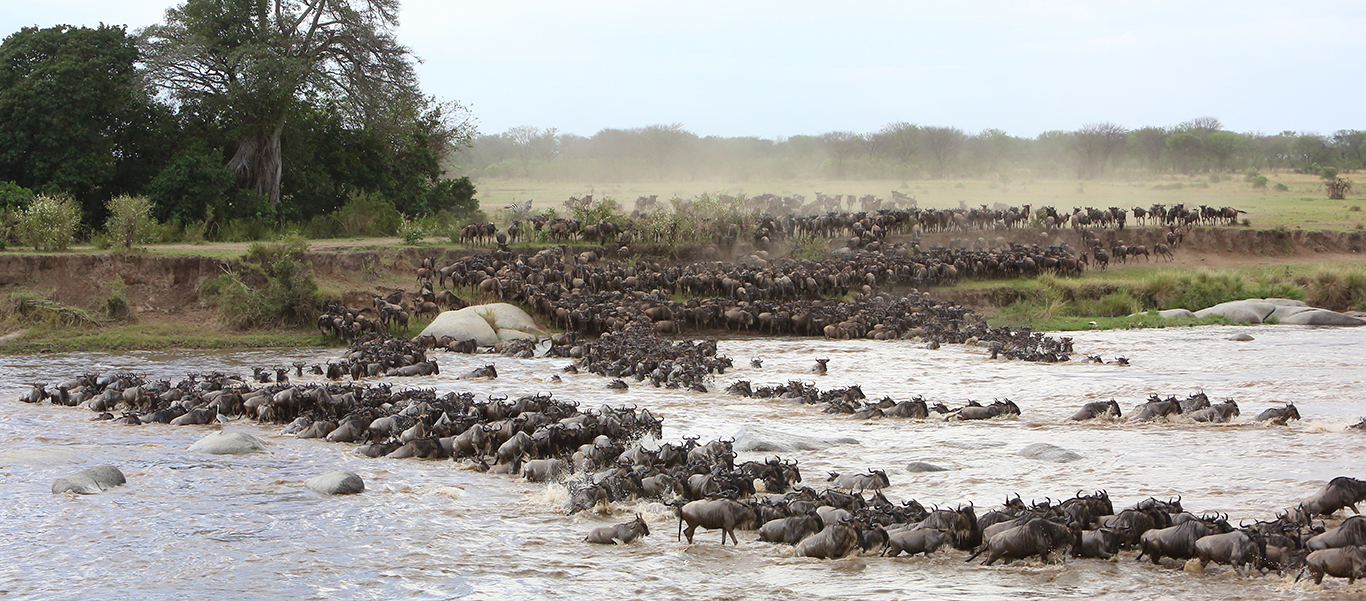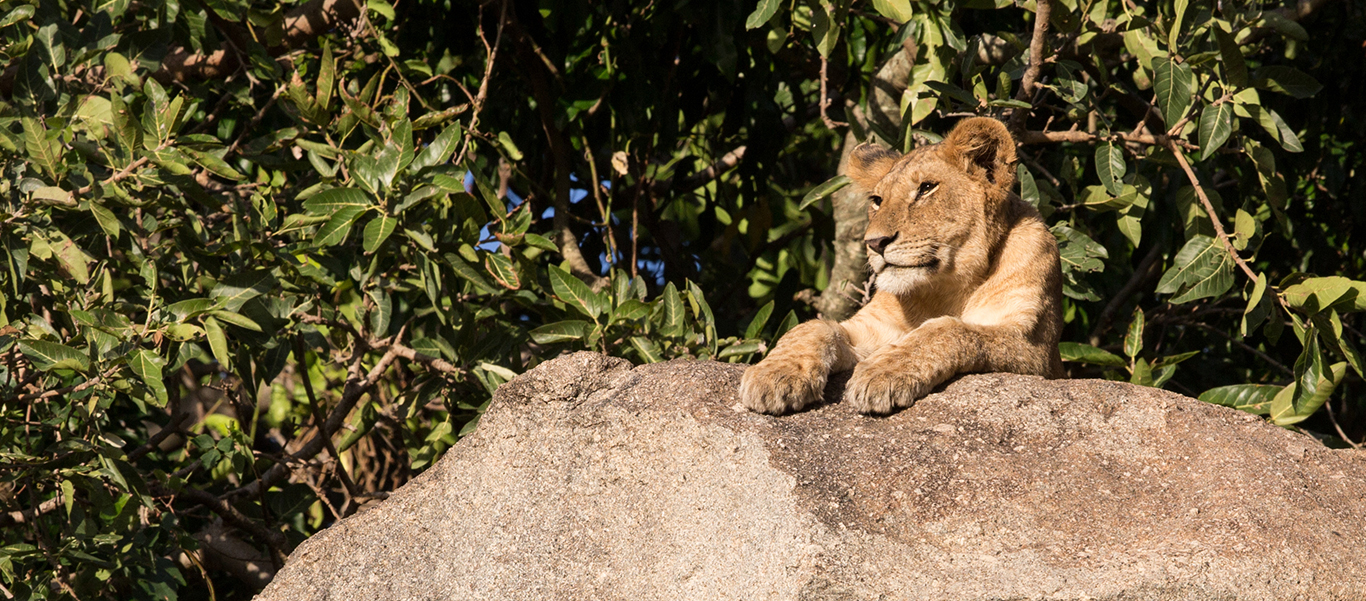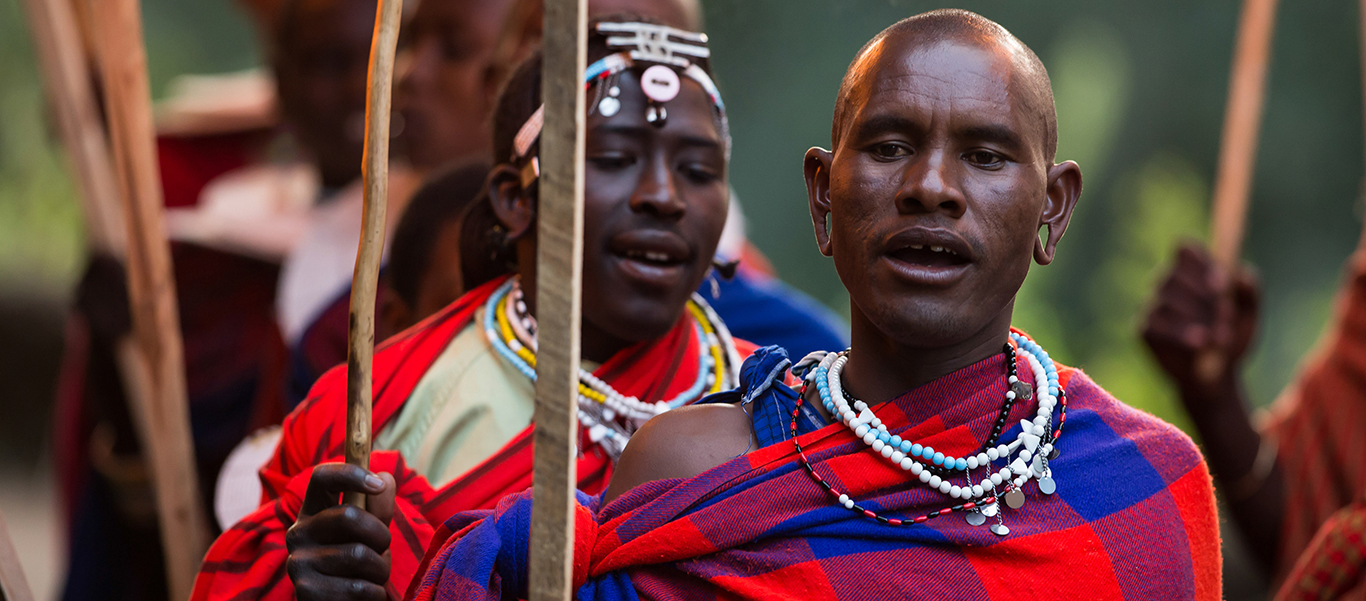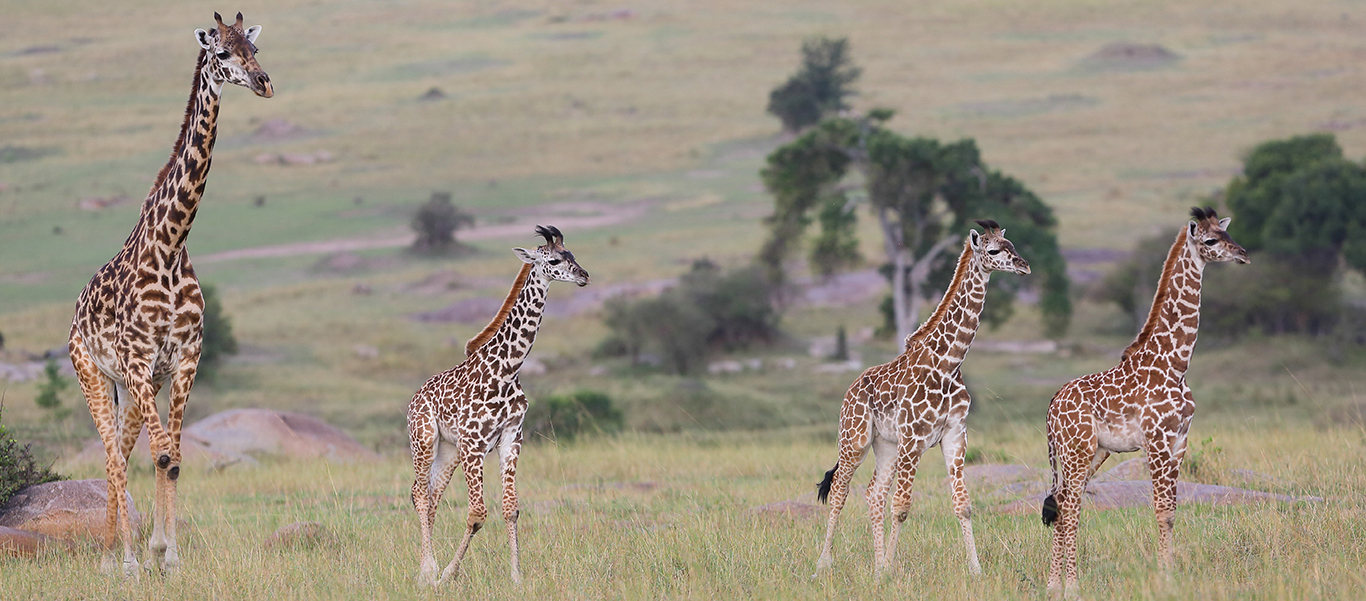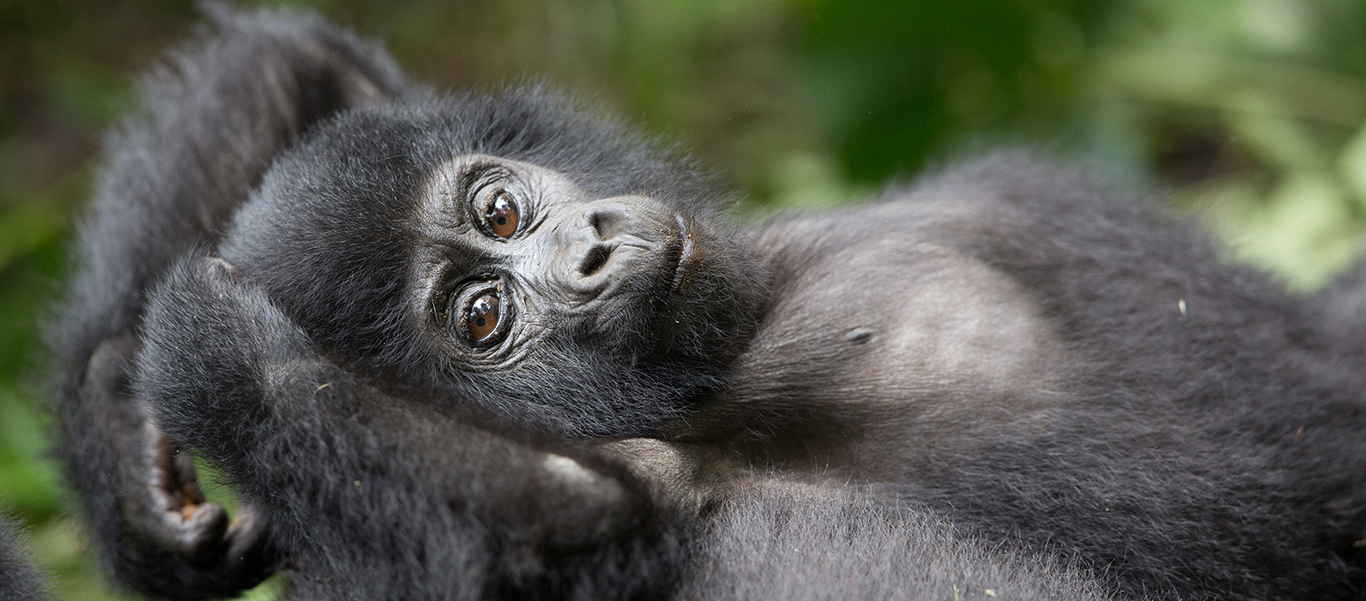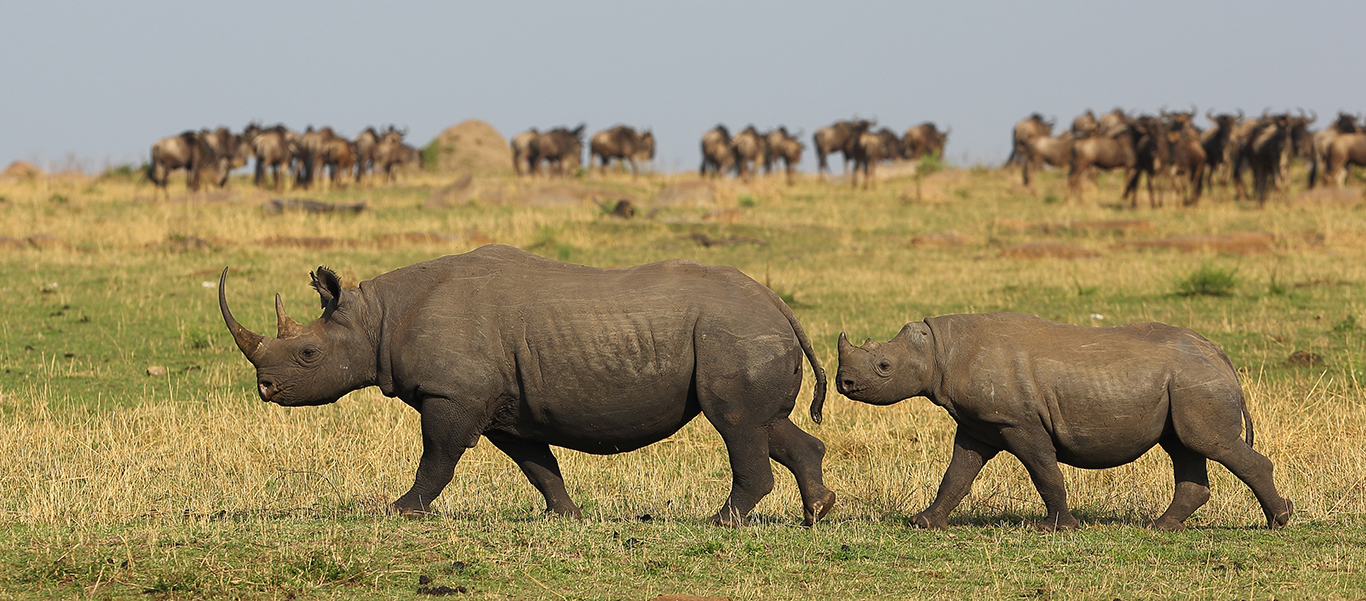Tanzania & Uganda
Uganda & Tanzania Safari Tour
Combining the world's largest wildlife migration and most dramatic savanna wildlife with a visit to the iconic Mountain Gorillas of Uganda, this expedition is an absolute must for African safari enthusiasts. From Tanzania’s Serengeti to Uganda’s Bwindi Impenetrable Forest, this journey may be considered an exploration in opposites—from sunny to mist-shrouded, flat to mountainous, arid to tropical. What each destination has in common, however, is a staggering volume of large mammals. Encounter tens of thousands of wildebeest, zebras, and gazelles during the Serengeti’s Great Migration. See elephants with impressive tusks, called Tuskers, and countless Lions in the world-renowned Ngorongoro Crater. Track the critically endangered Mountain Gorillas of Uganda’s Bwindi Impenetrable National Park. Be overwhelmed with wildlife on this carefully curated adventure into the most game-rich areas of east Africa.
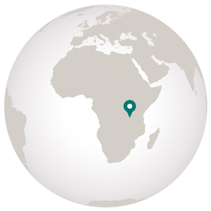
Destinations
- Travel by Air
- Travel by Road
- Travel by Boat
- Travel by Bullet Train
- Travel by Rail
- Travel by Dog Sled
-
Tuesday, August 23: Arusha
Arrive in Arusha, gateway to Mt. Kilimanjaro and the Ngorongoro Crater, and transfer to Legendary Lodge, nestled among lush gardens and working coffee estates. Gather this evening for a welcome dinner and briefing with your expedition leaders. Overnight at Legendary Lodge.
-
Wednesday, August 24: Arusha / Northern Serengeti
This morning, board a short flight to Serengeti National Park, 5,700 square miles of plains, open woodlands, and rivers that protect the most diverse collection of terrestrial wildlife on Earth, and one of the last great intact migratory systems. Home base will be Sayari Camp in the northern Serengeti, located a stone’s throw from the legendary Mara River, host to one of nature’s greatest spectacles—the dramatic wildebeest crossings. From July through September, the Great Migration passes by here, and two million Blue Wildebeest, zebra, and gazelle cross the crocodile-infested Mara River to get to the greener pastures of the Maasai Mara in Kenya. Sayari is Swahili for “universe,” an appropriate name for a location, which, in this season, feels like it’s sitting at the center of the wildlife cosmos. This afternoon, head out in search of wildlife. Predators will just be warming up for their night’s hunt. Dinner and overnight at Sayari Camp.
-
Thursday–Saturday, August 25–27: Northern Serengeti
You have three full days here to take in the prolific wildlife. Expect to see elephants, Hippos, lazing prides of Lion, Leopard, Cheetah, skulking Spotted Hyena, jackal and Bat-eared Fox. Ungulates abound, and in addition to the ever-present wildebeest, huge numbers of Burchell’s Zebra, buffalo, Giraffe, Warthog, and a seemingly endless variety of antelope may be seen. One of these mornings, you may decide to enjoy a sunrise bush breakfast at the river’s edge and wait to witness the spectacular wildebeest crossing. Sayari Camp also offers the rare opportunity to experience the Serengeti on foot, letting you further connect with its sights and sounds. Over 550 bird species reside here—some stars among them include Gray-breasted Spurfowl, the glamorous Fischer’s Lovebird and characterful Rufous-tailed Weaver, along with more widespread avian icons of the African savanna like the Bateleur, stunning Blue-capped Cordon-bleu, and the aptly named Beautiful Sunbird. Dinners and overnights at Sayari Camp.
-
Sunday, August 28: Serengeti Under Canvas
After a final morning at Sayari, a drive via safari vehicle will take you to a fully tented camp. Serengeti Under Canvas offers a true “Out of Africa” experience with meals prepared over traditional open fires called jikos, al fresco showers with water heated over the fire, and dining under the stars. The exact location of the campsite is planned according to the projected movements of the Great Migration, bringing you within comfortable driving distance of the heart of the herds. Although the species you encounter may be familiar, the experience will be quite new. Such is the magic of the African savanna—no two games drives are alike, no two regions the same, and the scene of an incredibly thrilling hunt one hour may be the scene of a birth the next. Dinner and overnight at our tented camp.
-
Monday, August 29: Serengeti Under Canvas
Another full day here will maximize your chance to encounter that elusive river crossing. Even if you don’t get lucky with a crossing, there will always be an abundance of wildlife to keep you happy. The Serengeti offers long, undisturbed views and utterly dramatic panoramas, and the green-gold, thorn tree-dotted savannas make it a spectacular landscape for photography. Take the opportunity to photograph herds of impala against the stark blue sky. See Topi, Kongoni, diminutive Kirk’s Dik-diks, Klipspringer, Roan, Oribi, Defassa Waterbuck, Bohor Reedbuck and Eland roaming the endless plains. Beside the large cats, several species of smaller cats such as Caracal, Serval and African Wild Cat are also numerous, and stunning to see stalking along the kopjes, or rocky outcrops, and river banks. Dinners and overnights at our tented camp.
-
Tuesday, August 30: Ngorongoro Crater
After breakfast, it’s back to the airstrip for a short flight to the Ngorongoro Conservation Area, a UNESCO World Heritage Site and home to the jaw-dropping Ngorongoro Crater and Serengeti Plains. Upon setting foot on the forest-carpeted caldera slopes, a striking array of animal life will present itself to you—see black and white Guereza Colobus Monkeys as they frolic in the trees, or fascinating birds ranging from the mighty Crowned Eagle to colorful Oriole Finches. After lunch, visit a local Maasai village. The Maasai people, a semi-nomadic tribe that live in Northern Tanzania and Kenya, are best known for the red cloth they wear called a Shuka, and their athletic jump-dancing, or Adumu, wherein warriors compete by jumping higher and higher while the others goad them on with song. Dinner and overnight at the scenic Ngorongoro Crater Lodge on the crater rim.
-
Wednesday, August 31: Ngorongoro Crater
Rise at dawn for an adventure into one of the world’s most spectacular wildlife sanctuaries, the 2,000-foot Ngorongoro Crater. The crater floor is an ecological microcosm of east Africa, with forests, lakes, grasslands, swamps and rivers that together support a staggering 30,000 large animals (most of whom are habituated to humans and quite relaxed). Huge concentrations of Blue Wildebeest and Burchell’s Zebra are accompanied by smaller numbers of elephant (including the crater’s famous Tuskers), buffalo, Hippopotamus, Topi, and Thomson’s and Grant’s Gazelles. Predators like Lion, Cheetah, Leopard, Spotted Hyena, Bat-eared Fox, and Golden and Black-backed Jackal abound. You may even be lucky enough to spot the critically endangered Black Rhino. Birders will not be disappointed—see rafts of Lesser Flamingo on Lake Magadi, giant Ostrich, Kori Bustard, Grey Crowned Crane, Lilac-breasted Roller, and raptors like the unique Secretarybird and majestic Long-crested Eagle. Ascend to Ngorongoro Crater Lodge for dinner and overnight.
-
Thursday, September 1: Ngorongoro Crater / Arusha / Entebbe
Enjoy a last morning on the crater’s rim before bidding farewell to the Serengeti. Transfer to Arusha for a flight to Entebbe this afternoon. Tanzania’s Acacia savannas will become a rapidly fading memory as you fly over Lake Victoria—Africa’s largest water body—and on to the densely populated farmland of Uganda. Transfer to the Protea Hotel Entebbe, on Lake Victoria’s glistening shore, for dinner and overnight.
-
Friday, September 2: Entebbe / Bwindi Impenetrable National Park
Rise early this morning for a trip to the nearby Mabamba Wetlands. While over 260 bird species have been recorded in this large tract of prime papyrus swampland, the ancient-looking Shoebill Stork is its star. Mabamba has also recently become a stronghold of Blue Swallows, and boasts a large number of the equally elusive Sitatunga. Early afternoon board a flight to Bwindi Impenetrable National Park. Gradually, the East African plateau rises into the highlands of the Albertine Rift, home to Bwindi Impenetrable Forest and its renowned primate denizens. Touch down amidst the tea plantations of the Kigezi highlands, and transfer to Gorilla Forest Camp, situated within the 128-square-mile National Park. A short hike takes you into the heart of the moss-draped primordial forest, where you may encounter your first primates here in the form of the attractive L’Hoest’s Monkey. Bwindi also boasts the highest number of Albertine Rift endemic birds of any park (23 of the 24). Watch for the incredible Great Blue Turaco, Luhder’s Bush-Shrike and White-tailed Blue Flycatcher. Dinner and overnight at Gorilla Forest Camp.
-
Saturday, September 3: Bwindi Impenetrable National Park
A short walk from the lodge brings you to Bwindi’s headquarters, the starting point of today’s gorilla tracking. Bwindi is home to 120 mammals; 10 of which are primates, notably Colobus Monkeys and Chimpanzees. But it is best known for its 340 gorillas, half of the world’s critically endangered Mountain Gorilla population (the other half living in the nearby Virunga Mountains of Rwanda). Follow your guide along the improbably steep rainforest trails—you may even spot an African Forest Elephant or Giant Forest Hog along the way—until tracks lead you off the path and into the canopy, and eventually to a family group. Habituated to visitors, these gorillas are unfazed by human presence. See females hum in appreciation while munching on vegetation, youngsters wrestle in the undergrowth, and the gargantuan silverback watch over them with a benevolent eye. It’s an experience you will likely never forget. Dinner and overnight at Gorilla Forest Camp.
-
Sunday, September 4: Bwindi Impenetrable National Park / Entebbe
Numbering about 700 individuals total, the Mountain Gorilla is now listed on the International Union for Conservation of Nature (IUCN) Red List of Critically Endangered Species due to habitat loss, poaching, disease and war. Tourism in the park contributes to the preservation of this magnificent species. There are four habituated family groups open to tourism in Bwindi. Today, visit a second gorilla group to witness a broader array of behavior and interaction. Keep your eyes peeled for some of the 350 bird species as well, including the African Green Broadbill and the Cream-banded Swallowtail. Red-tailed Monkeys and Vervets may also be seen dancing in the treetops overhead. This last evening in the forest, enjoy a farewell dinner and toast the many highlights of your adventures in Tanzania and Uganda. Overnight at Gorilla Forest Camp.
-
Monday, September 5: Entebbe
After a last breakfast amidst the deafening dawn chorus of Bwindi Forest, take a short flight back to Entebbe. Check into day rooms at The Protea and enjoy a light dinner in preparation for the early morning’s international flights out of Entebbe.
-
Tuesday, September 6: Entebbe
Transfer to Entebbe International Airport for your early morning international flights home.

